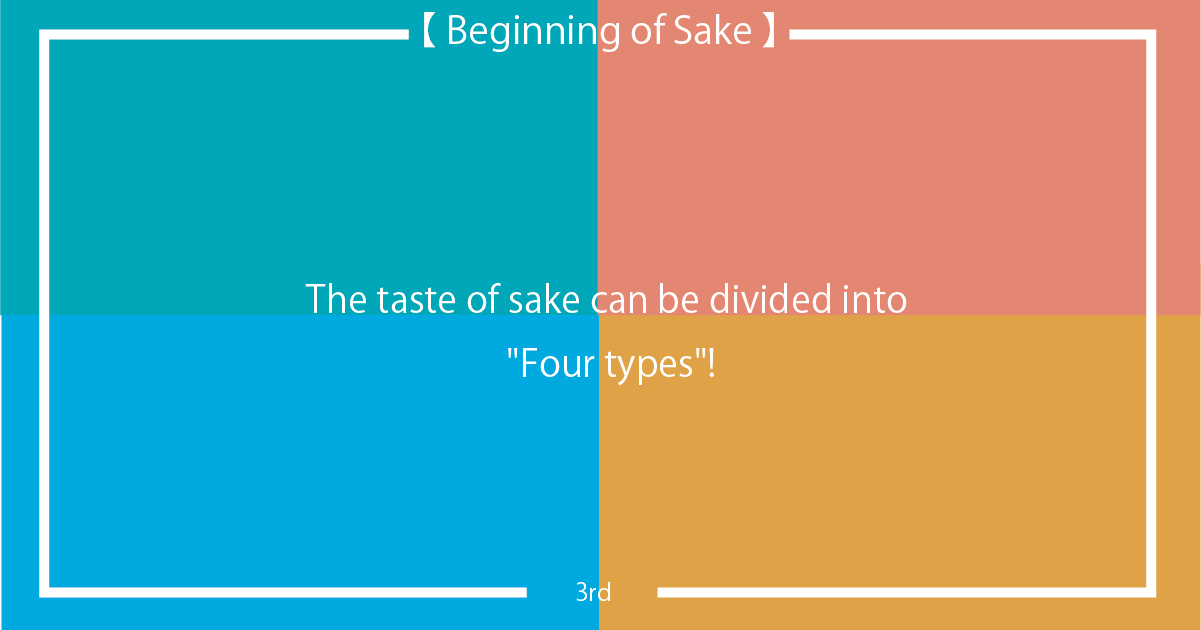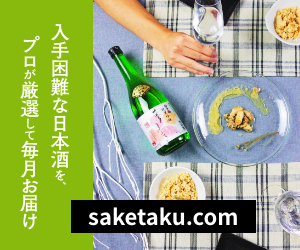- Home
- [Beginning of Sake] - Let's learn more about Sake!
- 3. The taste of sake can be divided into “4 types”!
3. The taste of sake can be divided into “4 types”!
- 2020/11/15
- 47 comments

In the previous article, “Explain the brewing way and characteristics of the six typical types of alcohol beverages!” we explained the basic knowledge of sake, including alcohol other than sake.
From this time on, we will use that knowledge as a base to explain the basic knowledge of sake.
When you go to liquor shops or restaurants which sells sake, you can see a lot of sake with different names, such as “Dassai” or “Juyondai”.
In most cases, when you choose alcoholic beverages, you want to drink alcoholic beverages with this taste, and you want to choose ones that suit your needs.
In the case of sake, information is written on labels, menus, POPs, etc. as information to know what the sake tastes like. For example, explanations such as “sweet” or “dry,” “light taste” or “rich taste” are written.
“Nihonshudo(an indicator of sweetness of sake)” is written as an index of spiciness.
However, when you saw such information, bought dry one and tried it, it was sweet unlike you imagined.
Conversely, you liked the sweet taste, so when you tried sweet one, you did not feel the sweetness.
Some people may have experienced such an experience.
This time, I will explain about such “taste of sake”.
Contents
Sake tastes other than “sweet and dry”
*Attention:
The below is translation of Japanese article.
In Japanese, “sweet” is “Amakuchi”, “dry” is “Karakuchi”. Moreover, in Japanese, “hot” is “Karai”.
To the point, in Japanese, “kara” is used for both “dry” and “hot”.
This often makes the Japanese confused.
I intended to write down the translation of Japanese.
Please keep in mind above and know the difference of taste between you and the Japanese.
The taste of “sweet or dry” varies considerably from person to person.
Therefore, it is common that information about the taste of alcoholic beverages or the feeling that they actually drank were different.
This is because sweet or dry of the food differs from the that of liquor.
In the case of food, sweetness means “something with sweetness”」 and dry means “something with strong spices or strong saltiness”.
In most cases, the more sweet ingredients you use, such as sugar, or other sweet seasonings, the sweeter the taste becomes.
Conversely, adding more spicy seasonings such as chili pepper makes it spicy, and adding more salt makes it salty.
On the other hand, in the case of alcohol, “sweet” means “high sugar content and weak alcohol irritation” and “dry” means “low sugar content and strong alcohol irritation”.
As I wrote in my previous article, the “sugar content” of alcohol is not necessarily sweet.
In addition to sugar and alcohol, alcoholic drinks also contain ingredients that make drinks feel sour and tasty.
Therefore, the ratio of these ingredients is complicatedly entangled and the taste changes.
Therefore, it is not always necessary to feel sweet because of the high sugar content, or bitter because of the high alcohol content.
For this reason, from the viewpoint of “sweet or dry”, the perception varies from person to person, the image of “sweet or dry” differs in the first place, so it is easy to misunderstand when you tell people about the taste of sake.
However, if that happens, people who want to know about the taste of sake will not understand the taste of sake very well.
Therefore, what I would like you to know about the taste of sake is not “sweet or dry,” but “Flavor characteristics” that classify sake by “smell” and “taste”.
“Taste types” are indispensable if you understand the taste of sake
This term “Flavor characteristics” is a way of classifying sake flavors that was invented by Sake Service Institute.
Sake Service Institute is an organization that conducts comprehensive research on sake, centered on research on how to provide sake and shochu, which are Japanese sake.
Through its educational activities, the organization aims to contribute to the development of sake culture in Japan, support related industries, and the succession of Japanese food culture.
The organization conducts research on sake and shochu, as well as qualification and accreditation.
Among the certifications of this organization are “KIkisakashi (sake sommelier)”, “Shochu KIkisakashi (shochu sommelier)” and “Sakasho (sake master)”.
I am qualified as one of these “KIkisakashi”.
In order to become a “KIkisakashi” the following things are necessary.
① read about 500 pages of texts and acquire knowledge about sake;
② drink sake and actually taste the difference of sake, and express it in text;
③ formulate and write sales promotion plans on what type of combination of cooking and alcoholic beverage to customers; and
④ convert them into text at a certain level
This series of articles on the basics of sake, so to speak, is based on what I have learned from educational programs such as the text of the “Kikisakeshi” and explain important topics in an easy-to-understand manner.
The educational program of the “Kikisakeshi” explains the taste and way of drink of sake based on the “Flavor characteristics”.
Therefore, this article will also discuss “Flavor types”.
Writing in this way, the term “Flavor characteristics” seems difficult”. But it’s not that hard.
“Flavor characteristics” is, in brief, as follows:
① Four categories of Japanese sake are classified by “smell” and “taste” combinations.
② Each category is named “Kunshu”, “Soshu”, “Junshu” and “Jukushu”.
“In addition, “smell” and “flavor” are referred to as “flavor” in Japanese.
In a certain famous gourmet comic, humans sense the ‘taste’ of food and drinks by perceiving both ‘smell’ and ‘taste’.
For example, eating without smelling, such as a cold or pinching the nose, makes the taste of food less noticeable.
This is because the smell is an important factor in perceiving taste.
In other words,
“Smell” + “Taste” = “Flavor”
When we come to think of it,
Classification by “Flavor characteristics” = “Smell” and “Taste”
So,
“Flavor characteristics” = Classification by “smell” and “taste” = Classification by “Flavor”
In other words, “flavor characteristics” can be referred to as “taste” classification.
In the following explanation, we would like to use the term “Taste type” instead of “flavor characteristics”.
One of the educational programs of “Kikisakeshi” is to drink these four types of alcohol and understand the differences between these types.
When I tried it, it was true that each taste had a different feeling.
I found that the taste of sake is divided into these four types, and among those classifications, they have characteristics such as strong umami, strong alcohol or sour taste.
Therefore, this time we will introduce the “Taste type” of sake, where you can see the characteristics of the flavor of sake”.
Knowing this makes it easy to understand what type of sake you like.
And it will be easier to choose when you choose alcoholic beverages, so be sure to know the type of flavor of this sake and try it when you choose alcoholic beverages.
The types of sake taste are divided into four

The Taste type of sake is classified into four categories according to “taste” and “smell” : “Kunshu”, “Soshu”, “Junshu” and “Jukushu”.
Criteria for classification are the two axes of “high/modest smell” and “rich/light taste”.
Now, let’s take a look at the characteristics of each Taste type, the corresponding sake, and the dishes that suit the right temperature and compatibility!
“Kunshu”: Japanese sake with a high aroma and a “refreshing taste”

Kunshu is an alcoholic beverage classified as “highly aromatic” or “simple in taste.”
The flavor height is characteristic.
The fragrance gives a gorgeous impression like fruit or flower, and the taste is cool and light.
The fruity flavor is also a popular type overseas, partly because of its proximity to wine.
The “Kunshu” type add new taste type to sake and make diversity.
With the advent of this type, the way of enjoying sake has diversified, such as drinking Japanese sake in wine glasses or drinking it with French or Italian dishes other than Japanese food.
For this reason, it is an important driving force for young people, women, and overseas sake booms.
Which sake falls under “Kunshu”?
[Typical Kunshu]
- Yamada Nishiki Junmai Daiginjoshu Urakasumi
- Dassai Junmai Daiginjo Migaki 23%
- Hakurakusei Junmai Daiginjo
“Kunshu” is mainly made from “Ginjo yeast”, which produces a fruity aroma (“ginjoko”).
In order to express this fragrance, it takes time to use high-definition rice (rice with a low rice-milling rate) or ferment it at a low temperature.
For this reason, the sale price of “Kunshu” is high.
Also, “Kunshu” is often seen in the ones that are labeled “Ginjo”.
For example, “Junmai Daiginjoshu” and “Junmai Ginjoshu” of the Junmai-shu, and “Daiginjoshu” and “Ginjoshu” of Honjozo-shu, are often categorized as “Kunshu.”
Explanation of appropriate temperature and compatible dishes of “Kurshui”
It is recommended to drink “Kurshui” at around 10℃ because it is a type with a high aroma.
The gorgeous and fruity aroma is made clearer by cooling.
However, be careful because too cold does not cause the smell to be felt and the sourness and bitterness that lies in the back tends to come out.
It is basically good to drink “Kunshu” cold.
As an exception, if the fragrance is modest and the flavor is clear, “Kunshu”, you can drink it deliciously even around 40°C (warmed).
“Kunshu” is an alcoholic beverage suitable for pre-meal alcoholic beverages due to its characteristics.
Like “Kunshu” the compatible dishes are gorgeous and make the most of the flavor of the ingredients.
For example, it goes well with dishes using seafood, such as carpaccio and herbs, as well as rolls in Vietnam.
Soshu: A sake with a moderate flavor and a smooth taste

“Soshu” is the lightest and smoothest of the four types.
For this reason, “Soshu” is referred to as “clear” or “easy to drink.”
In recent years, Soshu with less sweetness has also appeared.
Soshu is a popular sake that accounts for about 65% of the total amount of sake.
Especially, since around 1980, “the Light & Dry boom” has occurred in Japan, and the demand for “Soshu” has surged.
Among the four types, it was sold well because it can be manufactured at low cost and the price range is reasonable.
What sake falls under the category of Soshu?
[Typical Soshu]
- Kikusui Dry
- Hakkaisan Special Honjozoshu
- Kubota Senju, etc.
Basically, “Soshu” includes “Honjozo-shu,” sake made with high polished rice (with little ginjoko)” and “Namazake”.
In addition, since Brewers in Niigata Prefecture is based on the concept of “tanrei karakuchi (Light and Dry)”, it is said that almost all alcoholic beverages, regardless of their specific names, fall under the category of “Soshu.”
Explanation of Soshu’s moderate and compatible dishes
Since Soshu is clear, it is recommended to cool it to 5 to 10℃ to take advantage of this characteristic.
Also, if you cool too much, you feel that the original taste will be lost. However, since the original taste is light, there are no noticeable disadvantages such as “Kunshu”.
For this reason, the original taste of “Soshu” can be enjoyed by cooling and drinking it.
“Soshu” goes well with most dishes because of its lightness.
It doesn’t interfere with the dishes themselves, so it matches perfectly well with both the plain flavor dishes and the rich flavor dishes.
Please enjoy “Soshu” with your favorite dishes.
“Junshu”: Sake with suppressed aroma and “rich flavor”

The taste of “Junshu” is thick, the fragrance is conservative.
With a low rice-polishing ratio, it becomes a type of “THE SAKE”, where you can feel the umami (delicious) flavor derived from rice or rice malt.
Therefore, it is often referred to as “rich taste” or “full body”.
While it’s a bit peculiar, it’s a traditional taste. It’s attracting attention in the media in recent years.
Which sake falls under “Junshu”?
[Typical Junshu]
- Junmaishu Yae no Sakura
- Special Junmai-shu Urakasumi Ki-ippon
- Junmai-shu Kure
Among the Tokutei-meisho, Junmai-shu and special Junmai-shu are included.
In addition, “sake made from Kimoto-yeast”, ” with no filtration,” “raw sake,” etc. are also classified as a Junshu.
Explanation of appropriate temperature and compatible dishes of “Junshu”
“Junshu” is a wide temperature range among the four types of sake.
Therefore, depending on the type of alcoholic beverage, you can enjoy a different taste while adjusting temperature, such as 15 to 18℃ or 40 to 55℃.
Basically, “Junshu” is an alcoholic drink with a strong richness and umami ingredient.
To take advantage of this feature, it is recommended that you taste it with a slight warmer, or slightly lower than usual.
Due to these characteristics, “Junshu” is suitable for rich flavor dishes.
In particular, it goes well with rich dishes such as Karasumi(roe of Bora) or Shiokara(salted squid guts), which are staples of sake appetizers in Japan.
In addition, raw oysters with high umami ingredients are in synchronism with the umami of “Junshu”.
“Junshu” is an alcoholic beverage that goes very well with seafood because it has the highest effect of controlling the raw odor of dishes among the four categories.
“Jukushu”: sake with strong aroma and a “heavy flavor”

The “Jukushu” is characterized by a complex, concentrated scent and a high-sticky taste.
Because of this feature, the appearance is not transparent, but rather slightly colored, such as yellow or brown.
Among the four types, it can be said that it is the type of Sake that chooses the person to drink with the most unique taste.
In addition, many of these items are essentially expensive because of their manufacturing costs.
“Temperature” is important when making high-quality “Jukushu”.
The aging temperature must not be high or low.
Maintain exhaustive maturation temperature and take a long time to complete a delicious “Jukushu”.
Therefore, the cost of manufacturing is high, and there are many high-cost products.
Which sake falls under “Jukushu”?
[Typical Jukushu]
- Honjozoshu Eisen 20 years
- Daiginjo-shu Hizo Koshu Kakumei
- Honjozoshu Kamisugi Genshu Koshu etc.
“Koshu,” “Matured sake,” “Matured koshu,” “Long-matured sake,” and “Hizoshu” fall under “Jukushu”.
Regardless of Tokutei-meisho, long-mature sake that has been sleeping for more than 3 or 10 years is classified as “Jukushu”.
Explaining Jukushu’s moderate temperature and compatible dishes
The optimum temperature for “Jukushu” differs depending on the type of alcohol, just as for “Junshu”.
Mainly, 15-25°C or 35°C is a good temperature. However, because “jukuku” is a peculiar taste, it is also good to lower the temperature and reduce the fragrance and taste.
Be careful not to disrupt the balance between flavor and fragrance depending on the temperature when warming.
“Jukushu” is said to be suitable for after-meal because of its rich taste.
If you’re going to go with a dish, I recommend a unique dish that you wouldn’t go with any other type.
In particular, it goes well with strong-flavored dishes such as steak, yakiniku (grilled meat) and sukiyaki, fatty dishes, and spicy dishes such as Indian dishes.
Outfit: What happens to the classification of sake made by a special method?
Some sake is produced by a special method that is difficult to fit into four types.
Mainly, “sparkling sake”, “nigorizake (cloudy sake)”, “cask sake”, and “kijoshu(aged and sweet specialty sake)” can be said to be alcoholic beverages made using special manufacturing methods.
Therefore, we summarized below what happens when these sake are classified into four types.
[Classification of Sake Made by Special Production Method]
| Name | Classification by Taste type |
| Sparkling sake | “Soshu” |
| Nigorizake (cloudy sake) | “Junshu” |
| Cask sake | “Junshu” |
| “Kijoshu(aged and sweet specialty sake)” | “”Jukushu |
Sake produced by special production methods can also be classified into four types based on their smell and taste.
However, Sake is often classified in this way. This is not always the case.
For example, in the case of sparkling sake, which has a deep taste, it may be said that it is “Junshu” rather than “Soshu”.
Just consider what type applies to, based on classification by type 4.
Conclusion
- “Kunshu”: Sake with a high aroma and a “refreshing taste”
- Soshu: Sake with a moderate flavor and a smooth taste
- “Junshu”: Sake with suppressed aroma and “rich flavor”
- “Jukushu”: sake with strong aroma and a “heavy flavor”
I have explained the Taste types of sake.
Basically, sake can be divided into the above four types, each of which is characterized by its own taste.
If you remember these types of sake classifications, I think it would be easier to understand the characteristics of sake.
In particular, you can enjoy sake more deeply when you actually drink it if you know the appropriate temperature for each type and the appropriate dish.
When you drink sake from now on, remember the four types in this article and try practicing the appropriate drinking methods for each type.
(When you want to search for alcohol in the “type of flavor”, you can find it by choosing the “type of flavor” you want to investigate from here!)
Next time is the fourth “The taste of sake is determined by 8 elements! Explanation of knowledge to become common!”
[References] SAKE SERVICE INSTITUTE(SSI), “MOTOI of NIHONSHU”, NPO FBO 2018It's our great pleasure if this article is helpful for you.
Comment (0)
No trackbacks yet.










No comments yet.